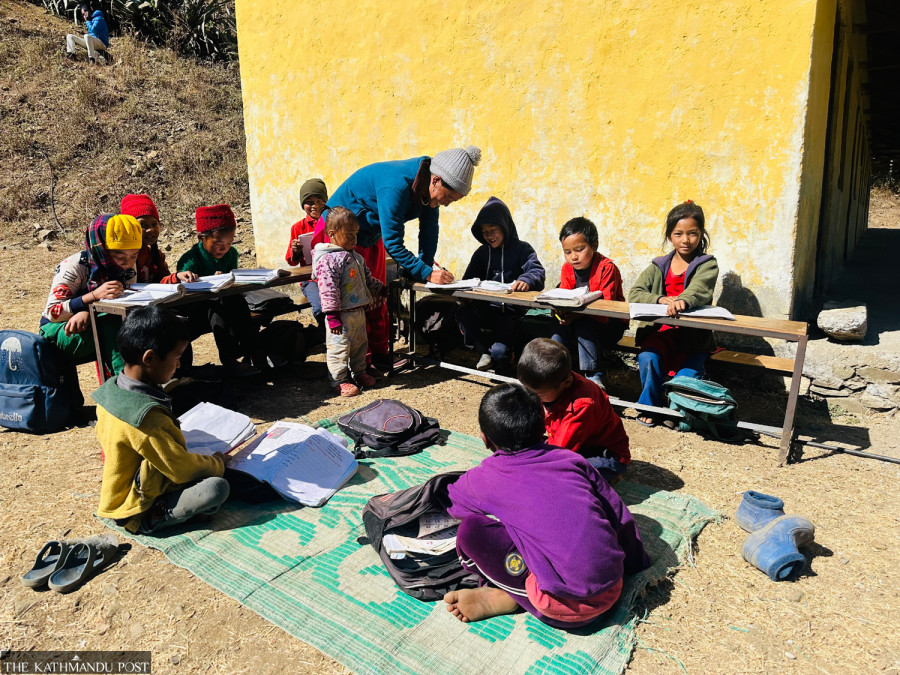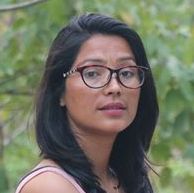National
Public schools are turning empty in Karnali Province
More than 30 percent of schools are struggling with low enrolment. Poor teaching at the schools is prompting parents to send wards to private schools.
Jyotee Katuwal
Manakamana Primary School, located in Ambasa in ward 7 of Kalimati Rural Municipality, Salyan, was established in 1996 at the request of the local residents and with permission from the then District Education Office. But now, the school faces a stark reality—there are no students.
Principal Lalita Salami Magar and office assistant Tika Budha dutifully attend the school every day, sign the attendance register, and return home. According to Magar, the school has classes up to grade three, but no students.
“The number of students started declining five years ago. In the last academic session, we had seven students, but there are none this year,” said Magar.
The trust of parents and students in public schools is decreasing, and it is so across the schools in the Karnali province. According to the Ministry of Social Development, Karnali, there are fewer than 10 students in 137 community schools in the province.
Bhairav Primary School, located at Luchchegada in ward 4 of Narayan Municipality, Dailekh, is also suffering from a shortage of students. There are only two students enrolled in the current academic session at Bhairab Primary School, which teaches up to grade five, according to the Integrated Educational Management Information System (IEMIS) of the Ministry of Social Development, Karnali.
Nade Rana, chairman of the school management committee of the Ambasa-based Manakamana Primary School, said that there are many reasons for the decline in student enrolment, with migration being the major cause.
Also, Ambasa borders the Banke National Park, which was announced in 2010. Soon after this, more people started leaving the place to avoid human-animal conflict and in search of better amenities.
“There are 45 households in Ambasa and only five to six children are of school-going age. Most of these children opt for private schools. We have asked the rural municipality office to consider merging the school with another so that they don’t have to pay salaries to staff and teachers with no students,” said Rana. “However, the rural municipality appears unwilling to do that because the school, albeit without students, has been providing employment to the relatives and family members of the municipal leaders,” Rana added.
"There are 35 primary and basic schools in Kalimati Rural Municipality, and among them, nine schools have less than ten students and 26 schools have less than 40 students. The rural municipality spends around Rs130 million on the salaries of the teachers at the primary, secondary, and higher secondary levels,” said Bharat Kumar Chand, head of the education unit of Kalimati Rural Municipality.
The government is spending millions in primary and basic schools, yet much of this money is being misused under the guise of paying salaries to teachers in schools with no students. Many teachers in remote areas continue to attend school even when no students are present. In such cases, locals also allege that teachers are misappropriating funds allocated for students’ mid-day meals.
There are only four students at the Mashta Basic School located in Neta, in ward 6 of Palata Rural Municipality, Kalikot. The school was established only two years ago.
According to Kal Bahadur Bhandari, head of the education unit of Palata Rural Municipality, there is one teacher at Mashta Basic School with an annual salary of Rs276,000. Similarly, Rs10,000 is spent on the textbooks of four students and Rs14,000 for the midday meal every year.
“There are 41 community schools in the rural municipality from kindergarten to grade 12, and among them, 38 primary and basic schools have very few students. The rural municipality spent Rs100 million per year on the schools, including on salaries for permanent, temporary, and temporary teachers appointed on relief quotas,” said Bhandari. “For quality education, it is necessary to merge schools, and currently, three schools, including Mashta Basic School, with less than ten students, are in need of immediate merger,” Bhandari added.
The number of students in most of the schools in the four local units of upper Dolpa is also very low. Sundari Basic School of Jagadulla Rural Municipality of upper Dolpa has only three students in the school who also do not attend classes regularly.
Jayas Upadhyaya, a Jagadulla resident, said most parents send their children to private schools as the quality of teaching-learning at community schools is poor.
After the number of students in the school decreased, some schools have even resorted to merging classrooms and combining students of various grades into a single class.
In most of the schools in Surkhet district, the headquarters of Karnali province, most of the primary and basic level community schools are running with less than 10 students.
According to the IEMIS of the Ministry of Social Development, Karnali, in the nine local units of Surkhet, there are fewer than two dozen students per school in 245 schools from kindergarten to primary levels.
And in Salyan, there are 266 schools in the ten local units of the district, and all these have less than 24 students per school.
Dhirendra Prasad Sharma, head of the education unit at Birendranagar Municipality, also blames the poor quality of education for the decline in student numbers at public schools. He also blames the poor implementation of federalism for the problem.
“This situation has arisen following the implementation of federalism, which he said has enabled local units to give permissions to new schools without proper needs assessment. Also, amid falling births, increasing migration, unmanaged urbanisation, and growing influence of private schools, has made it challenging to attract students to public schools,” said Sharma.
The Education Regulations 2002 stipulates that there should be at least 40 students in the schools in the mountain region, 45 in the hilly region, and 50 in the Tarai region.
According to the Education Development Directorate under the Ministry of Social Development, Karnali, there are 1,857 schools catering to grades 1 to 5, and 535 for grades 1 to 8. Likewise, 157 schools have fewer than 10 students. This all indicates that 30 percent of the province’s schools lack even the minimum enrolment requirement. Furthermore, 1,627 schools are operating with less than 40 students.
Meanwhile, Govinda Koirala, the central vice chairman of the Community School Management Committees' Federation, says the issue of poor enrolment in community schools can be improved if the school management committees worked proactively to improve the infrastructure and quality of education.
XXXXX
PHOTO: Owing to a small number of students and subject teachers at Chandrodaya Primary School in Lekbesi Rural Municipality of Surkhet, teacher Dhanasara Lamichhane has merged students from grade 1 to 5 into a single class. This photo was taken recently.
Sharing a classroom, students of grade one to three at Chandra Jyoti Primary School at Gurbhakot of Surkhet are seen learning by themselves in the absence of a teacher, in this recent photo.
POST PHOTO: JYOTI KATUWAL




 10.12°C Kathmandu
10.12°C Kathmandu
%20(1).jpg&w=200&height=120)














